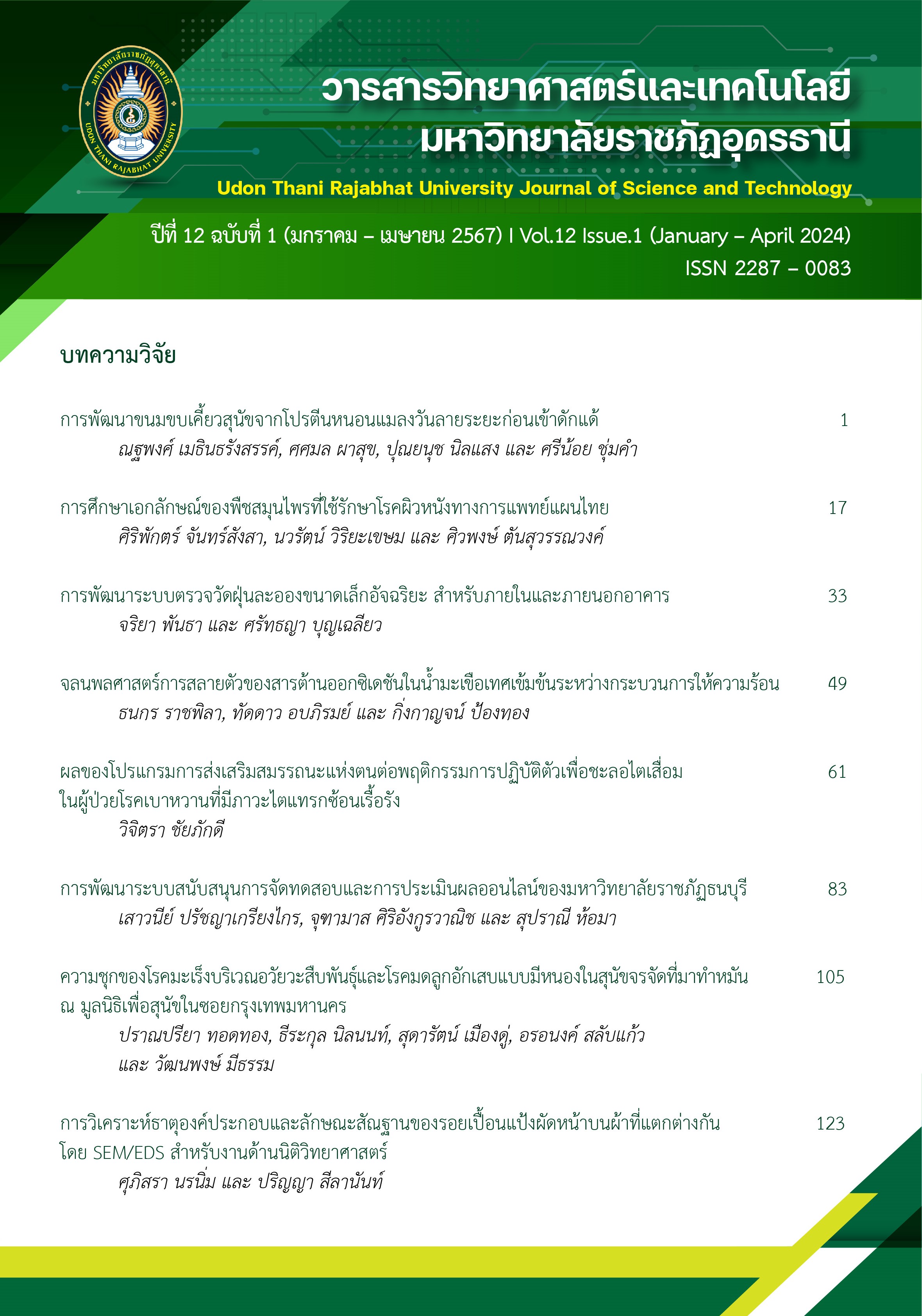ความชุกของโรคมะเร็งบริเวณอวัยวะสืบพันธุ์และโรคมดลูกอักเสบแบบมีหนองในสุนัขจรจัดที่มาทำหมัน ณ มูลนิธิเพื่อสุนัขในซอยกรุงเทพมหานคร
Main Article Content
บทคัดย่อ
โรคมะเร็งบริเวณอวัยวะสืบพันธุ์ (Transmissible Venereal Tumor; TVT) และโรคมดลูกอักเสบแบบมีหนอง (Pyometra) เป็นโรคทางระบบสืบพันธุ์ที่พบได้บ่อยในสุนัข โดยเฉพาะสุนัขจรจัดที่ไม่มีการควบคุม หรือถูกเลี้ยงดูแบบปล่อยปละละเลย ดังนั้นการศึกษาครั้งนี้มีวัตถุประสงค์เพื่อศึกษาความชุกของโรคมะเร็งบริเวณอวัยวะสืบพันธุ์ และโรคมดลูกอักเสบแบบมีหนอง ในสุนัขจรจัดที่เข้ารับบริการผ่าตัดทำหมัน ณ มูลนิธิเพื่อสุนัขในซอยกรุงเทพมหานคร เก็บข้อมูลจากสุนัขจรจัดที่มาทำหมัน ระหว่างเดือนพฤศจิกายน พ.ศ.2563 ถึง เดือนมีนาคม พ.ศ.2564 ทำการบันทึกข้อมูลสัตว์ อายุ เพศ สายพันธุ์ ตรวจร่างกาย และประเมินอาการทางคลินิก เพื่อแยกโรคทางระบบสืบพันธุ์ ได้แก่ โรคมะเร็งบริเวณอวัยวะสืบพันธุ์ และโรคมดลูกอักเสบแบบมีหนอง เก็บตัวอย่างเนื้อเยื่อไปตรวจวินิจฉัยแยกโรคทางห้องปฏิบัติการ และสรุปข้อมูลร้อยละความชุกของโรค ผลการศึกษาพบว่าสุนัขจรจัดที่มาทำหมันทั้งหมด จำนวน 1,482 ตัว แยกเป็นช่วงอายุ <1 ปี และอายุ >1 ปี จำนวน 208 ตัว (14.04%) และ 1,274 ตัว (85.96%) ตามลำดับ เพศผู้ จำนวน 343 ตัว (23.14%) และเพศเมีย จำนวน 1,139 ตัว (76.86%) และพันธุ์ผสม จำนวน 1,410 ตัว (95.14%) และพันธุ์แท้ จำนวน 72 ตัว (4.86%) พบร้อยละของโรคทางระบบสืบพันธุ์ จำนวน 97 ตัว (6.55%) แยกเป็นโรคมะเร็งบริเวณอวัยวะสืบพันธุ์ จำนวน 16 ตัว (16.49%) ช่วงอายุ >1 ปี จำนวน 16 ตัว (100.00 %) เป็นสุนัขเพศผู้ จำนวน 1 ตัว (6.25%) และเพศเมีย จำนวน 15 ตัว (93.75%) และพบเฉพาะพันธุ์ผสม จำนวน 16 ตัว (100.00%) และพบโรคมดลูกอักเสบแบบมีหนอง จำนวน 81 ตัว (83.51%) พบเฉพาะช่วงอายุ >1 ปี และเพศเมีย จำนวน 81 ตัว (100.00%) แบ่งเป็นพันธุ์ผสมจำนวน 79 ตัว (97.53%) และพันธุ์แท้จำนวน 2 ตัว (2.47%) จากการศึกษาครั้งนี้สรุปว่าโรคทางระบบสืบพันธุ์ที่เป็นปัญหาสำคัญ คือ โรคมดลูกอักเสบ
ซึ่งพบความชุกของโรคมากถึง 83.51% ของการพบโรคในสุนัขจรจัดที่มาทำหมัน ณ มูลนิธิเพื่อสุนัขในซอยกรุงเทพมหานคร
Article Details
เอกสารอ้างอิง
นงเยาว์ สุวรรณธาดา. (2544). โรคในระบบสืบพันธุ์เพศเมียสุนัขและแมว. คณะสัตวแพทย ศาสตร์ มหาวิทยาลัยขอนแก่น.
เปรม ชุนถนอม และ จรรยา พุกกะเวส. (2524). ทบทวนบทความทางวิชาการและรายงานโรค TRANSMISSIBLE VENEREAL TUMOR ที่เกิดที่อวัยวะอื่นโดยไม่พบที่อวัยวะเพศภายนอกของสุนัข. วารสารสัตวแพทย์, 1(2), 41-47.
สุพรรณิการ์ หาญตระกูล. (2557). การศึกษาคุณสมบัติทางเภสัชจลนศาสตร์และผลสัมฤทธิ์ทางคลินิกของยาเคมีบำบัดวินคริสตินในการ รักษาเนื้องอกระบบสืบพันธุ์ชนิด transmissible venereal tumor (TVT) ในสุนัข. (วิทยานิพนธ์วิทยาศาสตรมหาบัณฑิต, มหาวิทยาลัยเกษตรศาสตร์).
นิธิวดี เพ็ชรชู, เฉลิมขวัญ นนทะโคตร, นิตยา บุญบาล, อังคณา คนพูดเพราะ, สุปราณี จิตรเพียร, พิทัย กาญบุตร, นิรพรรณ วงษาไฮ, สุธิดา จันทร์ลุน, สุทธิศักดิ์ นพวิญญูวงศ์ และ นฤพนธ์ คําพา. (2551). การศึกษาย้อนหลัง: อายุ อาการทางคลินิกและค่าโลหิตวิทยาของสุนัขโรคมดลูกอักเสบแบบมีหนอง. น. 241-245. ใน: ประชุมวิชาการสัตวแพทยศาสตร์ มข. ครั้งที่ 9. วันที่ 11-12 มิถุนายน 2551. คณะสัตวแพทยศาสตร์ มหาวิทยาลัยขอนแก่น, ขอนแก่น.
Brown, N. O., Calvert, C., & MacEwen, E. G. (1980). Chemotherapeutic management of transmissible venereal tumors in 30 dogs. Journal of the American Veterinary Medical Association, 176, 983-986.
Cohen, D. (1985). The canine transmissible venereal tumor: a unique result of tumor progression. Advances in Cancer Research, 43, 75-112.
Das, U., & Das, A. K. (2000). Review of canine transmissible venereal sarcoma. Veterinary Research Communications, 24(8), 545-556.
Esmon, C. T., Fukudome, K., Mather, T., Bode, W., Regan, L. M., Stearns-Kurosawa, D. J., & Kurosawa, S. (1999). Inflammation, sepsis, and coagulation. Haematologica, 84(3), 254-259.
Goldschmidt, M. H. & Hendrick, M. J. (2002). Tumors of the Skin and Soft Tissues. In D. J. Meuten (Ed.), Tumors in Domestic Animals (4th Ed., pp. 47 - 50) Ames: Iowa State Press.
Hagman, R. (2022). Pyometra in Small Animals 2.0. Veterinary Clinics of North America: Small Animal Practice, 52(3), 631-657.
Jitpean, S., Hagman, R., Ström Holst, B., Höglund, O. V., Pettersson, A., & Egenvall, A. (2012). Breed variations in the incidence of pyometra and mammary tumours in Swedish dogs. Reproduction in Domestic Animals, 47(6), 347-350.
Johnson, C. A. (1998). Cystic endometrial hyperplasia and pyometra. In R. W. Nelson, & C. G. Cuouto (Ed.), Small animal internal medicine (2nd ed., pp. 870-873) Mosby: St. Louis.
Karlson, A. G., & Mann, F. C. (1952). The transmissible venereal tumor of dogs. Annals of the New York Academy of Sciences, 54, 1197-1213.
Kunakornsawat, S. Imsilp, K. Yatbantoong, N. Ratanapob, N. Supsavhad, W. Sreesampanand, S., & Nunklang, G. (2010). Vincristine Chemotherapeutic treatment for Transmissible Venereal Tumor in dogs. Kamphaengsaen Academic Journal, 8(2), 103-115.
Mukaratirwa, S., & Gruys, E. (2003). Canine transmissible venereal tumour: cytogenetic origin, immunophenotype, and immunobiology. A review. Veterinary Quarterly, 25, 101-111.
Oduye, O. O., Ihede, B. O., Esurnose, G. E., & Akpokodge, J. U. (1973). Metastatic transmissible venereal tumor in dogs. Journal of Small Animal Practice, 14, 625-637.
Otomo, K., Koike, T., Kudo, T., & Sakai, T. (1981). Histological and Ultrastructural Findings of Regressing Canine Transmissible Venereal Tumor after Repeated Transplantation. Nihon Juigaku Zasshi, 43(6), 823-832.
Prier, J. E., & Johnson, J. H. (1964). Malignancy in canine transmissible venereal tumor. Journal of the American Veterinary Medical Association, 145, 1092-1094.
Richardson, R. C. (1981). Canine transmissible venereal tumor. Compendium on Continuing Education for the Practising Veterinarian, 3, 951-959.
Stockmann, D., Ferrari, H. F., Andrade, A. L., Lopes, R. A., Cardoso, T. C., & Luvizotto, M. C. R. (2011). Canine Transmissible Venereal Tumors: Aspects Related to Programmed Cell Death. Brazilian Journal of Veterinary Pathology, 4(1), 67-75.
Sudjaidee, P., Theewasutrakul, P., Techarungchaikul, S., Ponglowhapan, S., & Chatdarong, K. (2012). Vincristine sulfate combined with L-Asparaginase in clinical vincristine-resistant cases: A case report. The Thai Journal of Veterinary Medicine, 42(1), 117-122.
Tella, M. A., Ajala, O. O., & Taiwo, V. O. (2004). Complete regression of transmissible venereal tumor (TVT) in Nigerian mongrel dogs with vincristine sulphate chemotherapy. African Journal of Biomedical Research, 7(3), 133-138.
Von Berky, A. G., & Townsend, W. L. (1993). The relationship between the prevalence of uterine lesions and the use of medroxyprogesterone acetate for canine population control. Australian Veterinary Journal, 70(7), 249-250.


